
Goodkind Bridge Account by Jessica Teal
Goodkind Bridge Account by Ray Brennan
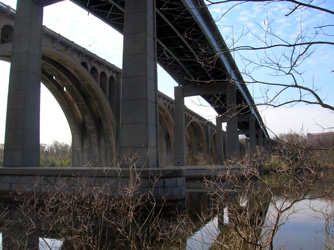
Where Kindness & Balance Begin: The Goodkind Bridges of New
Brunswick
by Jessica Teal
Crossing the Raritan and linking New Brunswick & Edison are two parallel bridges that I
never gave much thought to. If I was going to Loew"s theaters in New Brunswick, I would
cross on either the Northbound one or Southbound one, depending on what side of the
Raritan I was on/or wanted to get to. In any case, bridges were never a big deal to me
until the Rutgers Rarities project began and co-investigator Ray & I began to learn that
not only could weirdness be found on the banks of the Raritan, but also in the nooks and
crannies of the structures that enable us to cross it. The Morris Goodkind Bridge and the
Donald Goodkind Bridge (named for the father-son pair who designed both) are excellent
examples of this weirdness that stems, like so many Rutgers oddities, from Central
Jersey"s lifeblood, the old winding Raritan.
Now what caught Ray"s eye about these bridges was the interesting graffiti on the Edison
side that could be partially seen from some of the side streets that wind under the
pillars near Route 1. Also, the 2,000 foot-long bridges are exactly parallel but have an
obvious difference in age. The Northbound one, named after Morris Goodkind, was built in
1929 and is actually quite picturesque (for a Jersey bridge) with graceful swooping
arches and classical looking pillar-towers with commemorative plaques. The Southbound
one, named after Morris"s son, Donald, was built over 30 years later and reflects the
modern ideal of bridge aesthetics, which is, I guess, cost-driven and makes the economic
most out of the expensive steel and iron-work, which really means it"s just ugly and
boring. What"s not so ugly or boring is the graffiti that lines the bottom pillars and
the RR Team was quite impressed by the artwork and tags that make many statements about
the artists and their respective territories. It was while examining this work that Ray
& I saw some tagging done in some impossible looking places- namely the outer ledges up
near the top of the Donald Bridge. Now the drop from that spot is just plain scary. I
later found out that we're talking over 200 feet above ground and water. How did the
artist get up there, we wondered. And could we possibly do the same?
The answer is yes, but let me say right now- DO NOT TRY THIS YOURSELF. There is a tiny
little scaffold ladder that runs under the bridge that is extremely difficult to get
to. Ray managed to get to it by scaling a pipe that ran up one of the shorter pillars
and as agile as he is (he"s a friggin" spider-monkey), he nearly got injured in all
kinds of gruesome and scary ways in the risky ascent. As an uhhh, mildly interested
observer, I was sweating, flinching and seriously visualizing his funeral as he slowly
pulled himself up the ledges of the pillars, often with nothing more than the slightest
bit of narrow ledge to brace his weight upon. It was while I was drafting my memorial
service speech to Ray"s friends and loved ones that I noticed how incredibly high and
long the bridges ran. The Raritan may not be the Mississippi, but it"s a formidable
body of water and to drop into the water from that height would certainly mean death
with a resounding plop. I later read that this bridge in fact was the stage for a
suicide attempt in October of 2005. Luckily, the woman was rescued from the ledge in
that instance, but clearly this not a place to play around. Ray demonstrated some
amazing balance, bravery and focus in his pursuit of going where only the bravest
taggers of all had ever dared, but as far as plain old common sense goes, this is no
spot for the foolhardy, reckless or stupid. When Ray was on the scaffolding, which at
least offered secure footing, I felt greatly relieved, but the height he was at made him
little more than a dot far up above me. I couldn"t communicate with him in any possible
way from the ground and I hoped he wasn"t going to cross the entire length over to New
Brunswick. His head was directly underneath the roaring cars, trucks and buses and I
could make out that he was stooped and could only slowly sort of creep along the
scaffold.
He did eventually stop though, and the reason was not apparent to me until his return
back to land. As it turned out, the scaffold path was blocked by a large bird"s nest,
with its owner roosted on-site, which Ray would have had to push or mangle in some way
to pass. He made the smart choice to leave the bird and its nest unmolested and turn
back around at that point, as he knew he was tempting the fates as it was by being in
such a precarious position. To oust an innocent bird and/or its nestlings would have
just been wrong. The bird, itself, seemed rather stunned to see a human in its aerial
habitat- but who knows how it would have defended itself if messed with. Karmic balance
aside, the bird and its nest belonged on this bridge and Ray respected that fact. A
little kindness apparently goes a good way on the Goodkind bridge because I"m happy to
report that our fearless friend made it safely back down with only a few tricky moments
on his descent back down the pole.
Rutgers Rarities is hardly a project about stunts, although we sometimes get into
physically demanding situations due to the habitat/geography/locales of our
investigations. I've said it in other accounts, like the Waksman Tower account, and I"ll
say it again - Ray"s got some set of balls on him. The man has absolutely no fear of
heights and his physical agility and flabbergasting dexterity are without question. He"s
a Rutgers Rarity in his own right and I"m beginning to wonder just what his limits
are. Apparently they're dictated by conscionable decisions regarding the local fowl-life
while imminent death and/or injury rank a distant second. On our way out we noticed Ray"s
feathered friend peering down at us from the distant ledge of the scaffolding and I"m
certain that like me, that bird had a heck of a story to tell its friends that night
over a cold one. Check out these bridges sometime and drop us a line to tell us how
crazy/stupid/amazing/fearless Ray is. All opinions are welcome.

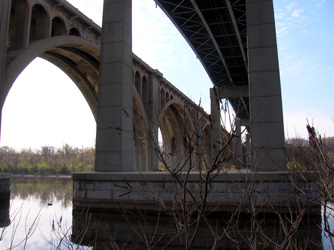

Some of the many angles of the Goodkind bridges showing the
scaffold (running down the center of the modern Donald Bridge), the tall concrete
pillars, and the Raritan River.


More views of the Donald Bridge from the graffiti-laced walls of the Morris Bridge (left)
and the ground level, 202-feet below (right).
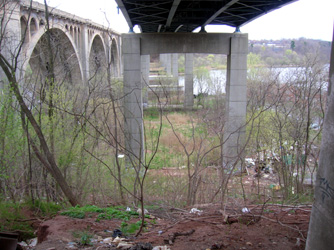
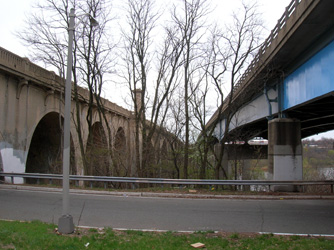
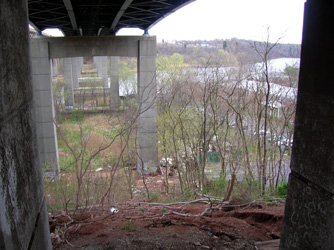
Betwixt and between the bridges, views of the beautiful landscape below.
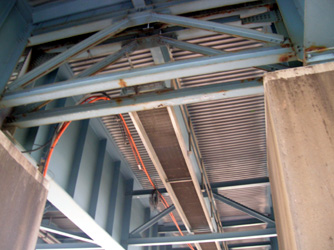
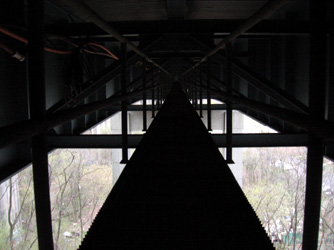
View of the scaffold from below and another view down the eye of the scaffold after
making the initial climb.
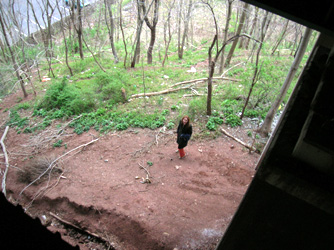
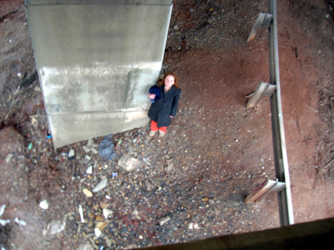
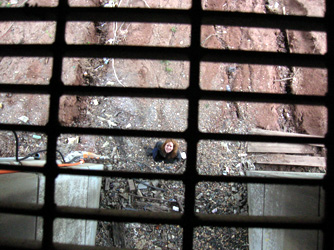
Perspective shots of Jessica from the scaffold entry point. The Teal Gauge indicates
that the smaller Jessica gets, the steeper the drop is.
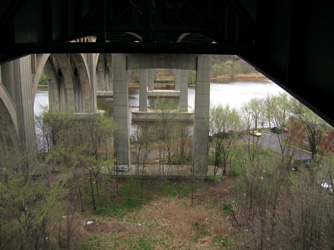
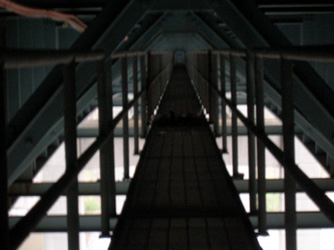
A shot from the pillar looking at the scaffold above and a shot of the turning point -
where the bird's nest and its occupants pleaded, "Do Not Disturb".
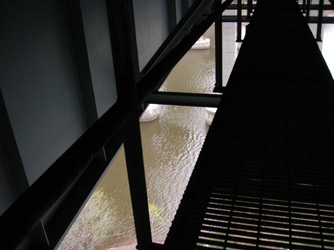
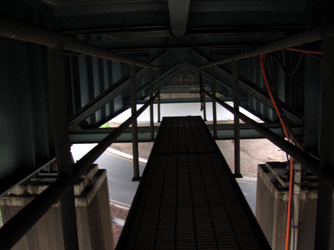
An image of the Raritan River over 200-feet below and an image of the end of the
scaffold after a long walk back.
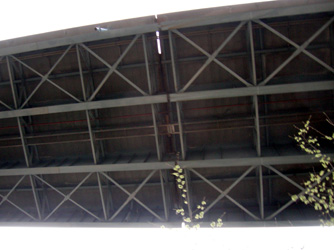
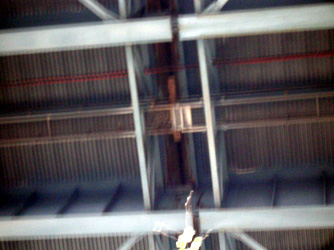
By respecting the aerial residence, a curious new feathered friend was made.
Close Encounters of the Goodkind aka What's Good and Kind and
Bridge All Over?
by Ray Brennan
What would Jackie do? That was the question I asked myself as I perused the Goodkind
Bridge from the ground up. After rifling through and shooting down the possibilities
of tackling the bridge, I noticed a potential way of connecting to the scaffold
above. There was a powder blue pipe running up one of the bridge"s pillars that looked
promising, and so I began the ascent in the name of Rutgers Rarities. One foothold led
to a bracket led to a short ledge led to the top of the pillar. After swinging,
dangling, and hanging at each juncture, the first phase was complete but the challenge
seemed far from over. There were beams and narrow openings leading to the center of the
bridge and the scaffold that ran the length of it. I realized by observing the gap
directly above me that cars were racing over me less than a foot from my head. What
would Jackie do? After carefully navigating the beams and squeezing through the narrow
opening, which was so tight that the loosening of my belt buckle was necessary for
passage, I had reached the edge of the scaffold. Looking down the eye of the
scaffold, it seemed never-ending. What would Jackie do? I started the long
journey. The rails on either side seemed secure, so I quickly made my way along the
scaffold, hunching over to avoid hitting my head on the bottom of the bridge. As I
looked down, the drop looked steeper as Jessica appeared smaller and smaller. When I
reached the tagged pillar, I scaled the ladder, descending to the top of the structure,
and it was then that I felt most vulnerable. There was no railing or support, the
wind had picked up, and I was several hundred feet above the ground. In that split
second, the gravity of the situation set in, but there was no time for that. What would
Jackie do? The call of the challenge resounded and the journey had to
continue. Climbing back onto the scaffold, I made my way above the edge of the
Raritan, but looking ahead, there was an obstacle in my way. The roadblock wasn"t a
gap in the path or a broken railing, but rather a large bird"s nest. What would
Jackie do? Instead of attempting to step over or trudge through the occupied nest, I
interpreted the obstruction as a sign to let sleeping birds lie. After leaving the
bridge inhabitants to their own devices, I turned around and made my way back down the
scaffold, content with the idea that I had not disrupted the karma of the structure
which had been both good and kind to me along the journey. I took in the view on the
way back, making my way to the edge of the scaffold as the ground inched closer and
closer. I crossed the beams carefully, as strong gusts of winds shifted my balance, and
made my way back to the narrow beam opening. While I had already had experience "under
my belt" as to how to pass through, it was no less painful squeezing between the
beams. I took a minute, watching the gap above me as the cars sped inches from my
head, and gathered my thoughts as to how I would approach the descent down the pipe back
to the ground. What would Jackie do? After sliding under the gap between the lowest
beam and the concrete pillar, I reached the top of the pipe, established a firm grip
with both hands, and swung down. Suspended, I used my feet to feel along the pipe for
a bracket to support my weight. Using a series of maneuvers, I slid my body down the
pipe until I reached the next foothold. The most difficult part of the climb was about
half way down the pipe, when I was hanging on one of the brackets and I couldn"t reach
the next ledge with my foot. I was forced to let go with one of my hands and hang on a
la Ethan Hunt, stretching my body just enough to secure the next step. Sliding down the
rest of the way, I had finally reached ground level. The rush of adrenaline
overshadowed any sense of achievement or accomplishment. Before walking away, I basked
once more in the overwhelming feeling, getting the smallest tip-of-the-tongue taste of
what I imagined it was like to be one of my heroes - Jackie Chan.
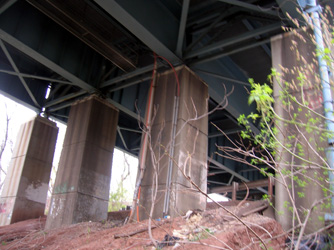
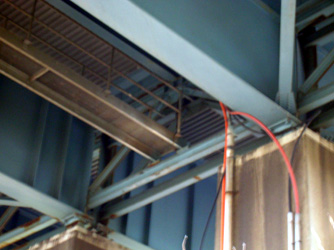
The pillars at the base of the bridge which allowed access
to the scaffold after some upward mobility. Attached to the right pillar is the powder
blue pipe that was scaled to reach the summit.


Views from the top and a look down the scaffold and at the landscape below.
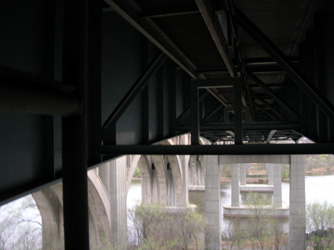
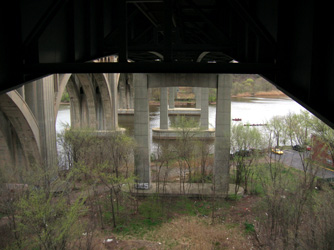
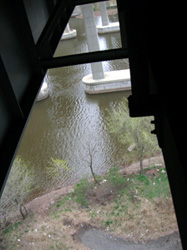
Shots from the concrete pillar looking up at the scaffold (left) and some shots of the
Raritan below from both the pillar (center) and the scaffold (right).
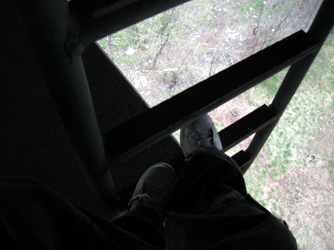
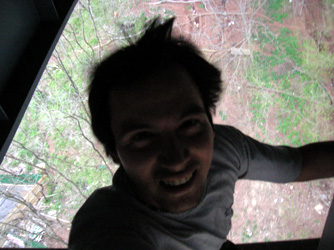
It's me - shots from the ladder and the air between me and the ground.
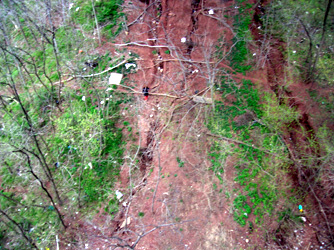
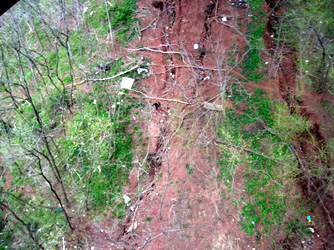

Forget Waldo - can you find Jess in the pictures above?.

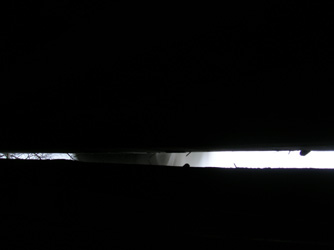

The bridge gap inches above my head as I stood on the beams. The gap with no cars
(left) and some shots with unidentified vehicles within reach (center, right).
©Rutgers Rarities and Unexplained Phenomena, 2005






















